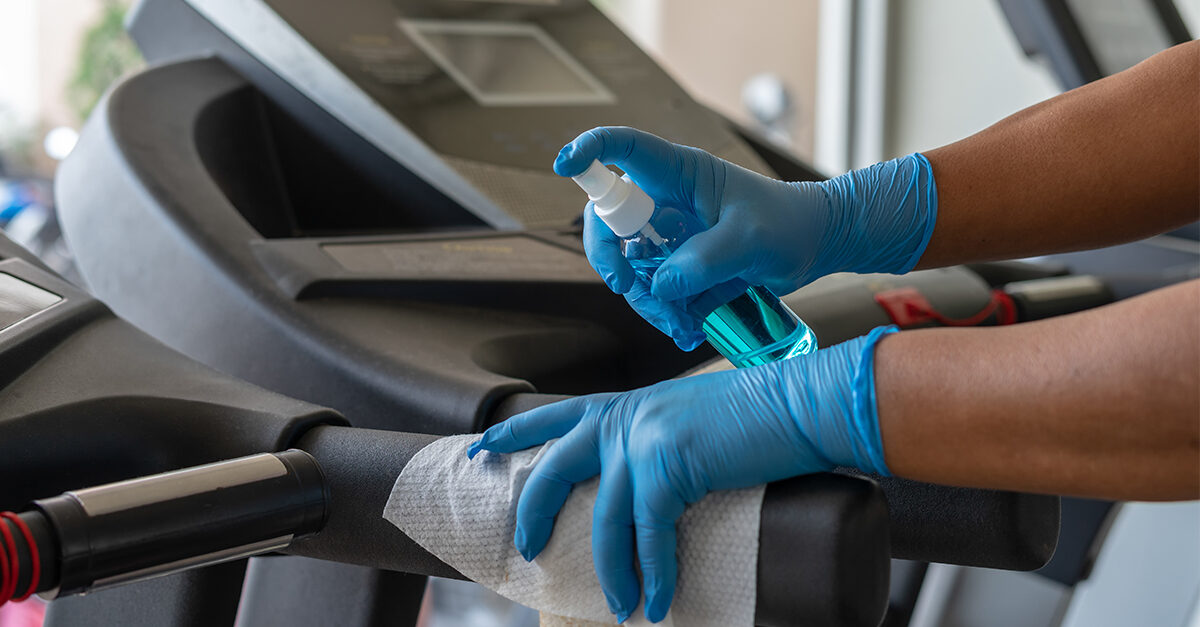It’s a new age for fitness centers due to the coronavirus. Your cleaning business can play a major role in helping these facilities reopen safely. According to a survey by Mindbody, 92% of consumers said that strict sanitization requirements will be critical in deciding whether or not to visit a gym when it reopens. Gym clients expect service providers to perform more stringent cleaning and disinfecting methods to ensure their members feel at ease when they return. Here are some considerations for how to meet new expectations.
Follow CDC guidelines
Revise your cleaning plan to address the elevated level of cleaning expected now and for the long-term. To combat the spread of illnesses, gym cleaning services will need a disinfection process that is effective and easy to implement.
Keep these tips in mind from the CDC in regard to safe cleaning practices for gyms to reopen:
- Take into account the type of surface and how much it is touched. Make disinfecting regularly handled surfaces a top priority, and disinfect all gym equipment after each use.
- Prior to disinfection, clean visibly dirty surfaces with soap and water.
- Use a disinfectant approved by the U.S. Environmental Protection Agency (EPA) against COVID-19, and read the label to ensure it meets your needs.
- Follow the directions on the labels of cleaning products for safety details and instructions for proper use.
- To clean and disinfect, use disposable gloves that can be discarded after each use, or use reusable gloves that are only used for cleaning and disinfecting. After removing gloves, always wash your hands.
Make sure machines and equipment are consistently disinfected, locker rooms are clean, and hand sanitizer and clean towels are present throughout the fitness center.
A clean gym is an important competitive advantage
Keeping a gym spotless and germ-free is now more crucial than ever. According to a study conducted by the International Health, Racquet & Sportsclub Association (IHRSA), gym cleanliness is one of the most powerful tools to boost member’s satisfaction, retain members, and catalyze revenue. The association’s report states that those who perceive their health club to be extremely clean are likely to recommend the facility to friends and family. Those who perceive the club to be unclean are significantly less likely to recommend it to a friend, colleague, or family member. In particular, new gym members and women are disproportionately inclined to value a clean workout and changing space.
The IHRSA study reports that 10% of members who recently terminated a gym membership state that the facility’s unclean environment played a role in their decision to quit. A clean gym boosts member retention and inspires current members. In order for gyms to reopen during COVID-19, your state may also have some specific reopening requirements in order to stay operational. This means that your partnership with the gym and collaboration on cleanliness efforts is vital for both of your businesses to operate. The moral of the story is that the fitness facility should be as clean, if not cleaner, than what members expect.
How to clean a fitness facility: Sweat the small stuff
The manner in which you clean gyms is as important as members’ perception of cleanliness. Depending on the gym owner’s preference, your team may be asked to perform deep cleanings throughout the day and not just late at night or early in the morning. After-hours cleaning won’t let members or gym management observe your commitment to a COVID-19-cautious cleaning regimen. Keep in mind that gym members may view the cleaning staff as the staff of the gym. Your staff who clean during open hours should be visible, friendly, and willing to accommodate reasonable member requests.
Many gyms that are reopening are asking clients to wipe off the equipment they use after each use. This does not mean that members are being asked to clean the entire facility, but you can work with the gym owner to properly space trash bins and designated cleaning stations throughout the gym. You can encourage the gym owner and staff to provide wipes or ample towels and disinfectant spray for gym equipment placed by machines. Convenient placement of gym equipment cleaner products will increase the odds that members do their part to keep the facility clean and that they will place undesired items in garbage cans and wipe down machines after using them.
How to clean gym equipment
Gym equipment is a magnet for bacteria and grime as one person after another uses it. Add in the fact that gyms tend to be warm environments and it is easy to see why germs are omnipresent. A consistent sanitizing of equipment will reduce the number of harmful bacteria, including viruses like SARS-CoV-2, that members may come in contact with. Use disinfectant gym equipment cleaning wipes to sanitize facility equipment several times per day. These gym cleaner wipes will help eliminate germs, grime, and sweat left on the machines from facility users.
It is important to note that there is an important distinction between disinfecting and sanitizing. Certain wet wipes disinfect, meaning their chemicals destroy bacteria and germs. This is essential as a disinfectant is needed to rid surfaces of body fluids like perspiration and saliva.
Your staff should use wipes in a nuanced manner. The full surface of the gym equipment should be thoroughly wiped. Let the machine completely dry before members are allowed to use it—this may take extra monitoring on your staff’s part. This period of time however allows the solution to completely destroy bacteria, and the disinfectant should be allowed to rest on the equipment for at least 2 to 3 minutes. If your cleaning staff is cleaning the facility late at night when few members are around or when the facility is closed, let the cleaning solution sit on the machines/equipment for 10 minutes or longer. This period of time allows the solution to completely destroy bacteria.
Cleaning gym equipment takes more than wipes
Wet wipes for disinfecting are only half the battle when it comes to gym cleanliness. Have your cleaning staff make use of gym disinfectant sprays or electrostatic or atomizing sprayers with disinfectant solutions to boot. Make sure to follow the directions on the disinfectant solution label, and apply it to machines on a regular basis. Leave spray bottles by popular machines along with disinfectant wet wipes, paper towels, and hand sanitizer.
There’s a wide selection of EPA List-N disinfectants that are approved to inactivate the coronavirus SARS-CoV-2. Check the label for this information, and note that a quaternary ammonia solution is safe to spray on surfaces members touch. This mixture does an excellent job of eliminating germs found on fitness center equipment. Train your cleaning staff on dwell times and how solution should stay on machine surfaces for the appropriate amount of time before being wiped off. Otherwise, the germs won’t be removed.
How to select the right equipment cleaning solution
If you want to cover all your bases, your cleaning staff should use an EPA-registered, antibacterial product. Antibacterial cleaning supplies for gyms will also disinfect. This means it will destroy the majority of viruses and germs found in fitness centers. Keep in mind that disinfectants have unique chemical combinations. Some are environmentally friendly with chemical agents sourced from citrus oils. Some are phenol-based while others are alcohol-based and pose a threat to workout machines. Avoid these types of gym cleaners as they are likely to corrode expensive gym equipment.
Beware of drying chemicals as they have the potential to cause gym equipment to prematurely wear down, crack, and age. Quaternary ammonia is ideal as it doesn’t pose a risk to humans or exercise machines. However, some quaternary ammonia solutions require a wet surface for upward of 10 minutes in order for disinfection to occur. Some of the newer versions of quaternary ammonia disinfect in as little as a couple of minutes.
Take care to avoid gym equipment cleaners that pose a threat to human health. Bleach kills germs yet it can harm skin, lungs, and clothing. Avoid hydrogen peroxide as it has the potential to result in rashes and severe irritation of the skin.
In the end, the cleaning solutions you select should be safe for the cleaning staff, gym members, and the fitness machines. When in doubt, read cleaning products’ labels, get a gauge of their limitations, and clean as frequently as possible.
Don’t forget to collect dust and dirt
Beyond spraying down machines with disinfectant spray for gym equipment, it is also necessary to vacuum around equipment. A thorough vacuuming will collect all debris and dust scattered around the exercise machines. Have your cleaning staff dust off all cardio equipment, weight machines, and weights. Make sure outlets, plugs, and wires are completely free of dust. Wipe the facility’s windows and clean off all door handles. Be sure to also perform a thorough cleaning of the locker rooms, showers, and bathrooms.
When in doubt, clean it!
During this health crisis, we’re all doing our best to stay healthy and safe. It is your cleaning staff’s duty to uphold the highest level of cleanliness as gyms reopen and help keep members, clients, and yourself protected. Don’t hesitate to consistently research any new COVID-19 guidelines and consult government agencies for updates. We’re in this together, and your cleaning business will thrive when people see that health and safety are a top priority.



